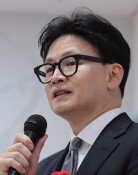Korean peninsula vs. Bush adm. (5)
Reduction of U.S. forces in Korea
Korean peninsula vs. Bush adm. (5)
Reduction of U.S. forces in Korea
Posted January. 22, 2001 11:44,
(1) Will N.K.-U.S. framework change?
(2) Powell`s Korea policy
(3) Revision of North Korean aid policy
(4) Impact of NMD and TMD
(5) Reduction of U.S. forces in Korea
(6) How to coordinate North Korea policies?
(7) Pressure to rise for market opening
Colin Powell, as secretary of state of the Bush administration, said Dec. 16 that the disposition of U.S. forces abroad would be reviewed but that there was no plan for withdrawing or reducing their numbers. President-elect George W. Bush told the New York Times on Jan. 14 that redeployment could be considered in consultation with South Korea and other allies if North Korea no longer posed a threat to its neighbors.
"The 37,000 U.S. troops in Korea is a clear signal that represents our determination and interest in the Pacific," said Powell during a Senate hearing on his confirmation on Jan. 17.
These are some of the official remarks made by Bush and his foreign policy team over the past month on U.S. military presence in Korea. They all predicate the possible pullout or reduction of American forces in Korea on the dissolution of military threat from Pyongyang and the consent of allies based on mutual consultation.
This seems somewhat removed from the talk of redeployment of American troops overseas emanating from Washington. As yet, many believe debate over possible cutback of U.S. forces in Korea has not gone away altogether. It owes to both internal and external conditions.
First of all, the military factors arise from within the United States.
The traditionally isolationist Republicans tend to avoid exposing American ground forces to dangers abroad. Vice President Dick Cheney, other assistants to President Bush and a group of military analysts have not spoken in full support of continued stationing of American servicemen in Korea at the present level. They are in favor of a new arrangement to reinforce the Air Force and Navy, while reducing ground troops.
Then comes the external element stemming from the current developments in the Korean peninsula. A wave of reconciliation is sweeping the peninsula since the inter-Korea summit in June 2000. It erodes the justification for keeping American troops here for the purpose of deterring North Korean aggression.
There will occur circumstances under which the scale and role of the U.S. forces in Korea need to be readjusted if and when North Korean strongman Kim Jong-Il pays a return visit to Seoul and starts negotiating a peace agreement, bringing about a substantial change in the security landscape of the Korean peninsula.
Not a few factors discourage early reduction or withdrawal of American soldiers from Korea. The part played by the U.S. forces here, as stabilizer and balancer in Northeast Asia would be here to stay for some time. The U.S. military presence has been a curb to the rise of Japan as a military power spurred by its rapid economic development. China also is aware of this. After the Pyongyang summit last year North Korea has taken an attitude of acquiescing to U.S. troops in Korea. The stake of Washington in the Asia-Pacific region is on a steady upturn.
The Pentagon will present its second four-year report on military strategy to Congress this year following the first report made in 1997. The report, the Quadrennial Defense Review (QDR) 2001, is expected to bring to light the changing military strategies and defense policies of the Bush administration.
Suh Dong-Man, professor of the Institute of Foreign Relations and National Security suggested the possibility of a change in U.S. military presence here over the medium and long term. No big change is likely for the moment, but most members of Bush's foreign and defense policy team will not be preoccupied with the magic number of 100,000 soldiers to be kept in Asia, he said.



![[단독]김경 “1억원 줄때, 강선우도 함께 있었다” 자수서](https://dimg.donga.com/c/138/175/90/1/wps/NEWS/IMAGE/2026/01/14/133148772.5.jpg)



